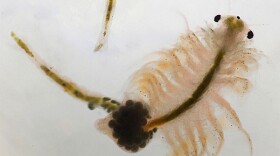-
At this month’s Science on Tap talk at the Cache bar in Logan, Great Salt Lake expert Jaimi Butler explained how brine shrimp inspired her career and the surprising sexualization of these crustaceans.
-
Looking ahead, Salt Lake City may once again host the winter Olympics in 2034. May our internationally renowned Great Salt Lake be present to welcome them, and may our snow be white and bright, not brown and gone, from a covering of dust blown from an empty lake bed.
-
In other news, Alpine School District is considering a district reconfiguration after a legal complaint.
-
Great Salt Lake has recently made headlines for increasing salinity and the threat that poses to the lake’s brine shrimp population. The Great Salt Lake Causeway seperates saltier North water from less salty South water. Researchers at Utah State University are studying the only opening in the North-South divide: the West Crack Breach.
-
New research suggests that as Great Salt Lake shrinks and gets saltier, brine shrimp, a staple food for migrating birds and a boon to Utah’s economy, may be in danger of dramatic population declines.
-
John Luft is the program manager for the Great Salt Lake Ecosystem Program, which manages the lake's brine shrimp fishery. He describes himself as a "sea monkey biologist."
-
Jaimi Butler has spent half her life studying the science, people and ecology of Great Salt Lake.
-
A group of Utahns are looking to get brine shrimp named as Utah’s state crustacean. The idea started with a student at Westminster College, but an aspiring sixth grade class in Salt Lake City is doing the legwork to make this a reality.
-
Brine shrimp are an abundant crustacean in Great Salt Lake, providing a critical source of food for migratory birds, and brine shrimp eggs are sold across the world as feed for aquaculture facilities, bringing in millions of dollars to Utah’s economy. Now, a group of Utahns are looking to instate brine shrimp as Utah’s state crustacean.

Play Live Radio
Next Up:
0:00
0:00
Available On Air Stations









